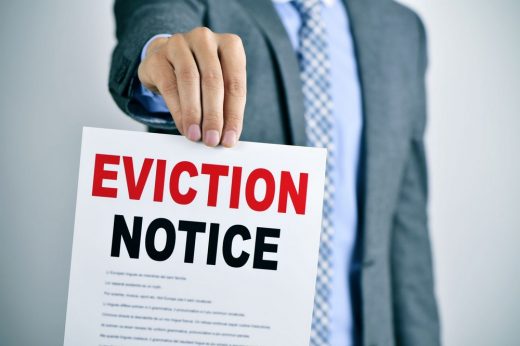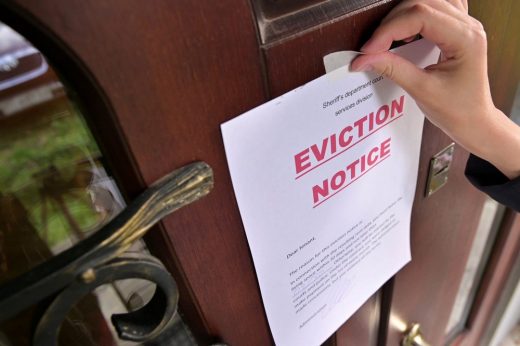The eviction process from start to end: what to know, Landlord legal tips, Online evict tenant advice
Eviction Process From Start To End: What To Know
24 Feb 2021
Evictions aren’t something you can take lightly, so you must be prepared and understand what the process entails. Many things go on behind the scenes when it comes to the eviction process. As a landlord, you must understand this process so you can execute it thoroughly and civilly.
If you’re new or unfamiliar with the eviction process, you should follow the steps indicated below. It’s essential to follow these steps so the court won’t hold any liabilities or illegal activities against you.
Eviction Process From Start To End Guide
Step 1: Determine A Valid Reason For Eviction
Before you start the eviction process, you need to determine a legal and valid reason why you want to evict your tenant so that the judge will rule in your favor. It could be any of the following:
- They failed to pay rent or are always late in paying rent.
- They’re violating the terms of the lease.
- They caused several property damages to the house or unit.
- They’re breaking health or other ordinances
- They cause health and safety hazards on the property
In case your reason isn’t included in the list, it’s crucial you gather evidence to prove that your tenant is causing harm to your property and other tenants in a building.
Step 2: You Have To Present A Formal Eviction Notice
If your tenant ignored the warnings you gave them before, you need to send them a formal eviction notice. Filing an eviction notice is a critical step because the tenant can claim squatter’s rights. Squatter’s rights are a legal allowance for anyone living on the property of another person in the absence of an eviction notice.
If you don’t present an eviction notice by adverse possession, the tenant can fight for the right on the property. With this law, the court gives the ‘squatter’ the right to own the property because they’ve been living there for some time, and it seems like the owner abandoned it.
The eviction notice’s primary purpose is to notify the tenant that they’re in default of their rental agreement. In other words, it tells them that they have to leave before a specific date; otherwise, legal action will be taken.
When drafting a formal eviction notice, you need to keep the following things in mind:
- Always include the specific date the tenant is required to vacate the property if they aren’t able to remedy their situation.
- In case rent is owed, you should detail how much the tenant owes you and include any fees.
- Ensure that you post the formal notice within the time frame you allow your tenant to remedy their situation. It should also post the end date of your ultimatum so you can meet your legal requirements.
- Place the formal eviction notice on their front door. You should also send the notification to them through the mail. Always include a return receipt so you can verify that the tenant received the document.
Formal eviction notices are used as legal evidence when you’ve officially defaulted on your lease or rental agreement. Since this is a legally binding agreement, you must honor it and ensure that you follow its terms. If you don’t, you could end up facing severe consequences, including possible fines and even jail time. Since eviction notices are used as legal evidence, you should take them very seriously. If you don’t comply with them, you may be held legally accountable for the debt and consequences that may result.
Step 3: Fill Up The Forms
In case the tenant wasn’t able to give in to your ultimatum, you should file a complaint about the unlawful detainer and, then, have the clerk issue a summons to formally start the case. Essentially, you’ll need to go through the legal process to get the other party to show up in court and answer the charges against them. After filing, the forms will be delivered to the tenant through the local sheriff’s office.
Step 4: Prepare For The Hearing
A hearing will be scheduled so you and the tenant will be given a chance to resolve the conflict one last time. Before you go to the hearing, you need to be prepared with the following documents:
- Lease agreement
- Records of all payments or non-payments, or bounced checks from the tenant
- Record of all your communication between the tenant
- A copy of the eviction notice
- Proof that the tenant received the eviction notice
During the eviction hearing, the court will give the renter and the property owner the chance to settle their case before the judge. It is at this point in the eviction process where both parties will be able to discuss the terms of the eviction, including how much money will be owed to the renter, how long the renter will have to leave the property, and other details that will have an impact on the eviction hearing outcome.
Step 5: Evicting The Tenant
The eviction of the tenant is the final part of the eviction process. This means all the belongings of the tenant will also be removed from the property. Even if the eviction hearing favored the landlord, any harassment or intimidation is illegal.
In case the tenant refuses to leave the property voluntarily, a court order shall be filed, which will be brought to local law enforcement, like the police. The police will be responsible for removing the tenant from the premises.
Eviction Process From Start To End Summary
Landlords shouldn’t just learn about landlord insurance, but the eviction process as well. Evictions occur for various reasons, but the most common is when the tenant is unable to pay their rent payments. Eviction can also be filed because the tenant poses a threat, or damages the property or harms other tenants. Whatever reason may it be, landlords have the responsibility to document and provide evidence why they want to evict their tenant.
All documents must be kept, including the formal eviction notice, payments, and other evidence to help their case in court. Even after the hearing, the law shall allow the tenant a specific time to vacate the premises. In case they don’t leave voluntarily, law enforcement will take over.
Comments on this guide to The Eviction Process From Start To End article are welcome.
Home
Residential Architecture Articles
Comments / photos for the The Eviction Process From Start To End: What To Know page welcome







